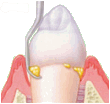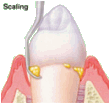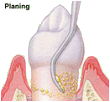
Dental Scaling and Root Planing
Tooth scaling and root planing (SRP) are the most common procedures for the treatment of periodontal disease (gum disease). For early stages of the disease (mild gingivitis), dental scaling and root planing are enough to help keep the gums healthy and firm. In more advanced periodontitis, the procedure acts as a necessary preparation before the required surgical treatments.
What is Dental Scaling and Root Planing
Tooth scaling is the procedure of scraping away the bacterial plaque and dental calculus (tartar) from the surfaces of the tooth, especially from the root surfaces below the gum line.
Root planing is the procedure of smoothing the root surfaces. If the root surface is rough it is much easier for bacteria and calculus to attach on it. Besides smoothing, the root planing removes any remaining plaque and calculus deposits trapped in these rough areas that could not be cleaned well by tooth scaling.
Removing dental plaque and calculus during the regular preventive dental visits every 6 months, can help prevent most of the tooth decay and gum disease problems. You should always check carefully before you choose a dental insurance plan if preventive dental visits and procedures such as 'professional cleaning' are covered.
Importance of tooth scaling and root planing for dental health
In many cases, good oral hygiene alone is not enough to prevent the accumulation of dental calculus below the gum line (sub-gingival calculus). The tooth scaling and root planing procedure is necessary for the removal of dental plaque and calculus from the surfaces of the tooth, as part of a gum disease treatment.
If teeth and gums are not cleaned properly, the gums begin to get irritated and inflamed. The gums start to loose their firm attachment to the tooth and recede (gum recession). The space between the gums and the teeth widens and deepens forming periodontal pockets that promote further accumulation of plaque and calculus. Up to this point, the condition is usually reversible by a SRP treatment followed by good oral hygiene.
Further infection of the gums leads to severe periodontitis. The infection process results in extensive loss of gum tissue and jaw bone. In this case, only periodontal surgery treatment can restore some of the damage and save the tooth. Otherwise, the tooth looses its supportive tissues, loosens and finally falls off. Dental scaling works only as a necessary preparation procedure for the surgical treatments that have to follow.
Scaling teeth and root planing is a recommended procedure for treating periodontal disease when periodontal pockets have become greater than 3 mm.
The dental scaling and root planing procedure
If you have mild gingivitis, periodontal scaling and root planing is usually completed in one appointment. If there is a periodontitis problem more visits will be required. Your dentist or periodontist typically will be scaling the teeth at a quarter of your mouth (quadrant) on each visit.
The tooth scaling and root planing procedure can cause serious discomfort in some patients, who have receding gums exposing the sensitive root surface or have dentin abrasions. Handling root areas of exposed dentin with dental instruments can be extremely painful. A local anesthetic is used to numb the area to be treated. Some type of light dental sedation may be recommended for some patients.
Periodontal scaling and root planing is usually performed with a combination of ultrasonic and hand instruments called dental scalers. Different instruments are used for different teeth, and even for different surfaces of the same tooth. Typically, ultrasonic scalers are used first to remove large deposits of plaque and calculus from the crowns and roots of the teeth. Ultrasonic instruments operate by vibrating the tip of the scaler in very high frequency, along with a water irrigating system used to remove the debris and cool the treated area. The vibrations can remove dental plaque and calculus without damaging the tooth’s surface.

Hand dental scalers then are used to complete the teeth scaling by scraping away any remaining calculus, especially from the pockets between the tooth and gums below the gum line. Hand dental scalers come in various shapes and sizes of the cutting edges with bladed, balled or pointed tips.

Afterwards the dentist will plane any irregular surfaces of the roots, so that the smoothened surfaces make it more difficult for plaque to accumulate. This dental root planing procedure is very important in preventing similar problems in the future. A smooth clean root provides a healthy environment to allow the gums to heal naturally and reattach to the tooth. This will create a reduced pocket, therefore eliminating areas for bacteria to hide and cause further disease.
Finally the teeth are polished to create a smooth surface. Polishing is performed using a rubber cup with an abrasive paste on the crown portion of the tooth.
In some cases, systemic antibiotics (usually antibiotic pills) are prescribed or locally-administered antibiotics (such as Periochip) are placed into periodontal pockets at the time of scaling and root planing procedures. Antibiotic treatment can help to eliminate any remaining bacteria in the periodontal pockets.
Tooth pain after dental scaling and root planing
It is absolutely normal to experience some pain after teeth scaling and planing, especially if you had a tooth sensitivity problem before the procedure. Before the periodontal scaling some exposed dentin tubules might be covered by calculus ‘protecting’ them from external stimuli that could cause sensitivity pain. But after the calculus is scraped away the dentin becomes exposed again, explaining the incidents of increased tooth pain after tooth scaling and root planing procedures.
The removal of the irritating factors from the gums will decrease the gum inflammation. As a result, the gums will seem to shrink and recede, and in some cases, revealing a severe gum recession that might need surgical treatment of gum disease. For some days after the treatment, the gums may also feel sore and tender. Some gum bleeding during brushing can be expected for the first days. Dentists may recommend an over the counter pain reliever to comfort the patient from the tooth pain after scaling and planing. An anti-microbial mouthrinse may also be prescribed if the patient feels discomfort during brushing due to sore gums. The tooth sensitivity may be treated by applying a fluoride varnish on the exposed areas of the roots.
A follow-up appointment must be scheduled 1-2 months after teeth scaling, for the dentist to check the gum healing and the reduction in the depth of the periodontal pockets.
Cost of dental scaling and root planing
The average fee that dentists charge for deep scaling and root planing is about $225 for each quadrant.
However the cost may vary depending on how many dental appointments are needed for the completion of treatment. For patients with mild gingivitis problems, the SRP procedure may be completed in only one visit, with a lower treatment cost.
If the scaling and root planing procedure is performed by a periodontist, you should expect a higher fee.
Periodontal Tooth Scaling and Root Planing combined with a strict home care routine and more frequent dental cleanings and exams will increase your chances of keeping your natural smile for a lifetime.

